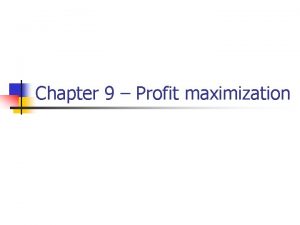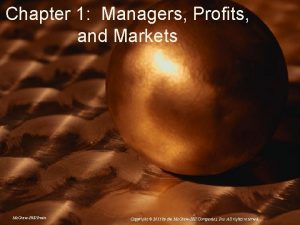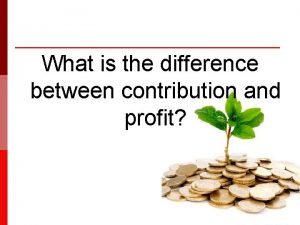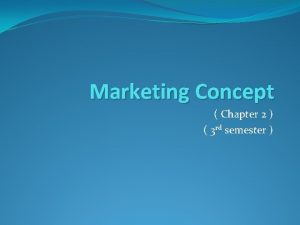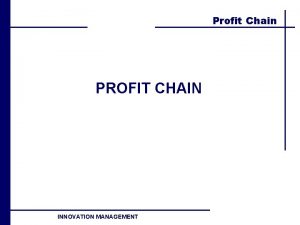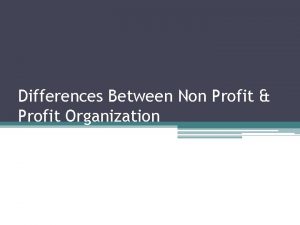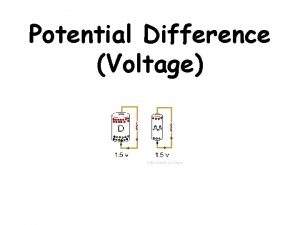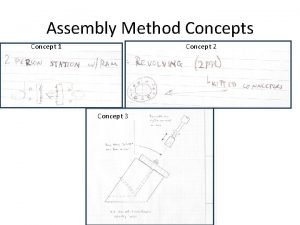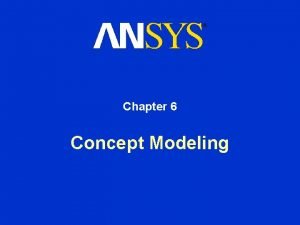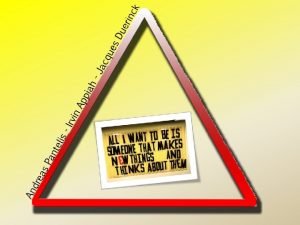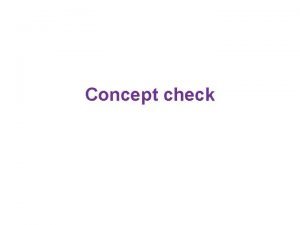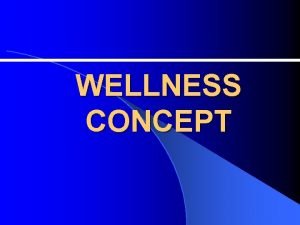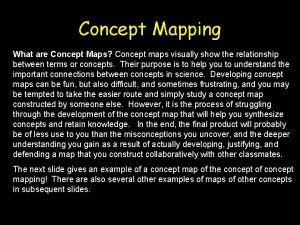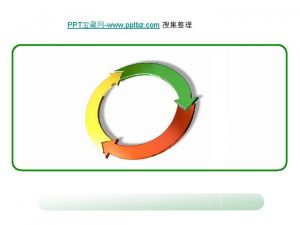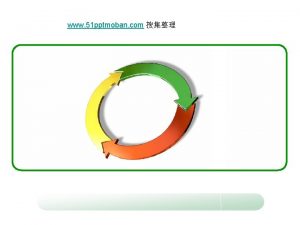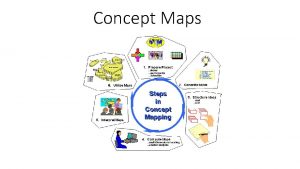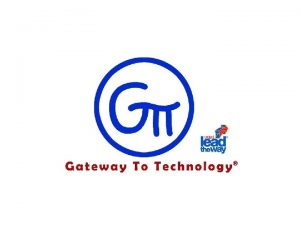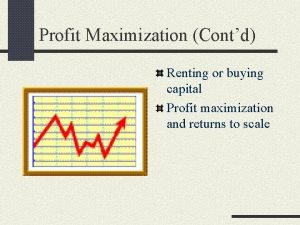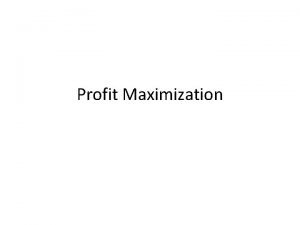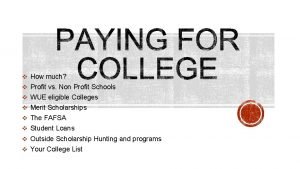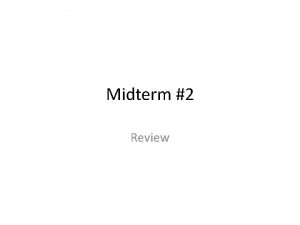The Concept of Profit Profit is the difference






































- Slides: 38

The Concept of Profit • Profit is the difference between total revenue and total cost. • The economic concept of profit takes into account the opportunity cost of capital. • Total economic cost includes a normal rate of return. A normal rate of return is the rate that is just sufficient to keep current investors interested in the industry. • Breaking even is a situation in which a firm is earning exactly a normal rate of return. © 2002 Prentice Hall Business Publishing Principles of Economics, 6/e Karl Case, Ray Fair

Maximizing Profit–An Example Blue Velvet Car Wash Weekly Costs TOTAL VARIABLE COSTS (TVC) (800 WASHES) TOTAL FIXED COSTS (TFC) 1. Normal return to investors $ 1, 000 2. Other fixed costs (maintenance contract, insurance, etc. ) 1. Labor 2. Materials TOTAL COSTS (TC = TFC + TVC) $ 1, 000 600 Total revenue (TR) at P = $5 (800 x $5) $ 4, 000 $ 1, 600 Profit (TR - TC) 1, 000 $ 2, 000 • If Blue Velvet washes 800 cars each week, it takes in revenues of $4, 000. • This revenue is sufficient to cover both fixed costs of $2, 000 and variable costs of $1, 600, leaving a positive economic profit of $400 per week. © 2002 Prentice Hall Business Publishing $ 3, 600 Principles of Economics, 6/e Karl Case, Ray Fair $ 400

Firm Earning Positive Profits in the Short Run • To maximize profit, the firm sets the level of output where marginal revenue equals marginal cost. © 2002 Prentice Hall Business Publishing Principles of Economics, 6/e Karl Case, Ray Fair

Firm Earning Positive Profits in the Short Run • Profit is the difference between total revenue and total cost. © 2002 Prentice Hall Business Publishing Principles of Economics, 6/e Karl Case, Ray Fair

Minimizing Losses • Operating profit (or loss) or net operating revenue equals total revenue minus total variable cost (TR – TVC). • If revenues exceed variable costs, operating profit is positive and can be used to offset fixed costs and reduce losses, and it will pay the firm to keep operating. © 2002 Prentice Hall Business Publishing Principles of Economics, 6/e Karl Case, Ray Fair

Minimizing Losses • Operating profit (or loss) or net operating revenue equals total revenue minus total variable cost (TR – TVC). • If revenues are smaller than variable costs, the firm suffers operating losses that push total losses above fixed costs. In this case, the firm can minimize its losses by shutting down. © 2002 Prentice Hall Business Publishing Principles of Economics, 6/e Karl Case, Ray Fair

Minimizing Losses A Firm Will Operate If Total Revenue Covers Total Variable Cost CASE 1: SHUT DOWN Total Revenue (q = 0) CASE 2: OPERATE AT PRICE = $3 $ 0 Total Revenue ($3 x 800) $ 2, 400 Fixed costs Variable costs Total costs $ 2, 000 + 0 $ 2, 000 Fixed costs Variable costs Total costs $ 2, 000 + 1, 600 $ 3, 600 Profit/loss (TR - TC) - $ 2, 000 Operating profit/loss (TR - TVC) Total profit/loss (TR - TC) $ 800 - $ 1, 200 © 2002 Prentice Hall Business Publishing Principles of Economics, 6/e Karl Case, Ray Fair

Minimizing Losses • When price equals $3. 50, revenue is sufficient to cover total variable cost but not total cost. © 2002 Prentice Hall Business Publishing Principles of Economics, 6/e Karl Case, Ray Fair

Minimizing Losses • As long as price (which is equal to average revenue per unit) is sufficient to cover average variable costs, the firm stands to gain by operating instead of shutting down. © 2002 Prentice Hall Business Publishing Principles of Economics, 6/e Karl Case, Ray Fair

Minimizing Losses • The difference between ATC and AVC equals AFC. Then, AFC q = TFC (the brown area). © 2002 Prentice Hall Business Publishing Principles of Economics, 6/e Karl Case, Ray Fair

Minimizing Losses • The blue area equals losses. • The green area equals operating profit. © 2002 Prentice Hall Business Publishing Principles of Economics, 6/e Karl Case, Ray Fair

Shutting Down to Minimize Loss A Firm Will Shut Down If Total Revenue Is Less Than Total Variable Cost CASE 1: SHUT DOWN Total Revenue (q = 0) CASE 2: OPERATE AT PRICE = $1. 50 $ 0 Total revenue ($1. 50 x 800) $ 1, 200 Fixed costs Variable costs Total costs $ 2, 000 + 0 $ 2, 000 Fixed costs Variable costs Total costs $ 2, 000 + 1, 600 $ 3, 600 Profit/loss (TR - TC) - $ 2, 000 Operating profit/loss (TR - TVC) Total profit/loss (TR - TC) - $ 400 - $ 2, 400 © 2002 Prentice Hall Business Publishing Principles of Economics, 6/e Karl Case, Ray Fair

Short-Run Supply Curve of a Perfectly Competitive Firm • The short-run supply curve of a competitive firm is the part of its marginal cost curve that lies above its average variable cost curve. © 2002 Prentice Hall Business Publishing Principles of Economics, 6/e Karl Case, Ray Fair

The Short-Run Industry Supply Curve • The industry supply curve in the short-run is the horizontal sum of the marginal cost curves (above AVC) of all the firms in an industry. © 2002 Prentice Hall Business Publishing Principles of Economics, 6/e Karl Case, Ray Fair

Profits, Losses, and Perfectly Competitive Firm Decisions in the Long and Short Run SHORT-RUN CONDITION Profits TR > TC Losses 1. With operating profit (TR TVC) 2. With operating losses (TR < TVC) SHORT-RUN DECISION LONG-RUN DECISION P = MC: operate Expand: new firms enter P = MC: operate Contract: firms exit (losses < fixed costs) Shut down: Contract: firms exit losses = fixed costs • In the short-run, firms have to decide how much to produce in the current scale of plant. • In the long-run, firms have to choose among many potential scales of plant. © 2002 Prentice Hall Business Publishing Principles of Economics, 6/e Karl Case, Ray Fair

Long-Run Costs: Economies and Diseconomies of Scale • Increasing returns to scale, or economies of scale, refers to an increase in a firm’s scale of production, which leads to lower average costs per unit produced. © 2002 Prentice Hall Business Publishing Principles of Economics, 6/e Karl Case, Ray Fair

Long-Run Costs: Economies and Diseconomies of Scale • Constant returns to scale refers to an increase in a firm’s scale of production, which has no effect on average costs per unit produced. © 2002 Prentice Hall Business Publishing Principles of Economics, 6/e Karl Case, Ray Fair

Long-Run Costs: Economies and Diseconomies of Scale • Decreasing returns to scale refers to an increase in a firm’s scale of production, which leads to higher average costs per unit produced. © 2002 Prentice Hall Business Publishing Principles of Economics, 6/e Karl Case, Ray Fair

The Long-Run Average Cost Curve • The long-run average cost curve (LRAC) is a graph that shows the different scales on which a firm can choose to operate in the long-run. Each scale of operation defines a different short-run. © 2002 Prentice Hall Business Publishing Principles of Economics, 6/e Karl Case, Ray Fair

The Long-Run Average Cost Curve • The long run average cost curve of a firm exhibiting economies of scale is downwardsloping. © 2002 Prentice Hall Business Publishing Principles of Economics, 6/e Karl Case, Ray Fair

Weekly Costs Showing Economies of Scale in Egg Production JONES FARM 15 hours of labor (implicit value $8 per hour) Feed, other variable costs Transport costs Land capital costs attributable to egg production Total output Average cost CHICKEN LITTLE EGG FARMS INC. Labor Feed, other variable costs Transport costs Land capital costs $120 25 15 17 $177 2, 400 eggs $. 074 per egg TOTAL WEEKLY COSTS $ 5, 128 4, 115 2, 431 19, 230 $30, 904 1, 600, 000 eggs $. 019 per egg Total output Average cost © 2002 Prentice Hall Business Publishing TOTAL WEEKLY COSTS Principles of Economics, 6/e Karl Case, Ray Fair

A Firm Exhibiting Economies and Diseconomies of Scale • The long-run average cost curve of a firm that eventually exhibits diseconomies of scale becomes upward-sloping. © 2002 Prentice Hall Business Publishing Principles of Economics, 6/e Karl Case, Ray Fair

Optimal Scale of Plant • The optimal scale of plant is the scale that minimizes average cost. © 2002 Prentice Hall Business Publishing Principles of Economics, 6/e Karl Case, Ray Fair

Long-Run Adjustments to Short-Run Conditions • Firms expand in the long-run when increasing returns to scale are available. © 2002 Prentice Hall Business Publishing Principles of Economics, 6/e Karl Case, Ray Fair

Long-Run Adjustments to Short-Run Conditions • Prices will be driven down to the minimum point on the LRAC curve. © 2002 Prentice Hall Business Publishing Principles of Economics, 6/e Karl Case, Ray Fair

Short-Run Profits: Expansion to Equilibrium • The existence of positive profits will attract new entrants to an industry. • As capital flows into the industry, the supply curve shifts to the right, and price falls. • Firms will continue to expand as long as there are economies of scale to be realized, and new firms will continue to enter as long as positive profits are being earned. © 2002 Prentice Hall Business Publishing Principles of Economics, 6/e Karl Case, Ray Fair

Short-Run Losses: Contraction to Equilibrium • When firms in an industry suffer losses, there is an incentive for them to exit. © 2002 Prentice Hall Business Publishing Principles of Economics, 6/e Karl Case, Ray Fair

Short-Run Losses: Contraction to Equilibrium • As firms exit, the supply curve shifts from S to S’, driving price up to P*. © 2002 Prentice Hall Business Publishing Principles of Economics, 6/e Karl Case, Ray Fair

Short-Run Losses: Contraction to Equilibrium • The industry eventually returns to long-run equilibrium and losses are eliminated. © 2002 Prentice Hall Business Publishing Principles of Economics, 6/e Karl Case, Ray Fair

Short-Run Profits: Contraction to Equilibrium • As long as losses are being sustained in an industry, firms will shut down and leave the industry, thus reducing supply. • As this happens, price rises. • This gradual price rise reduces losses for firms remaining in the industry until those losses are ultimately eliminated. © 2002 Prentice Hall Business Publishing Principles of Economics, 6/e Karl Case, Ray Fair

Long-Run Equilibrium in Perfectly Competitive Output Markets • Whether we begin with an industry in which firms are earning profits or suffering losses, the final long-run competitive equilibrium condition is the same. • In the long-run, equilibrium price (P*) is equal to long-run average cost, short-run marginal cost, and short-run average cost. Profits are driven to zero. © 2002 Prentice Hall Business Publishing Principles of Economics, 6/e Karl Case, Ray Fair

The Long-Run Adjustment Mechanism • The central idea in our discussion of entry, exit, expansion, and contraction is this: • In efficient markets, investment capital flows toward profit opportunities. • The actual process is complex and varies from industry to industry. © 2002 Prentice Hall Business Publishing Principles of Economics, 6/e Karl Case, Ray Fair

The Long-Run Adjustment Mechanism • The central idea in our discussion of entry, exit, expansion, and contraction is this: • Investment—in the form of new firms and expanding old firms—will over time tend to favor those industries in which profits are being made, and over time industries in which firms are suffering losses will gradually contract from disinvestment. © 2002 Prentice Hall Business Publishing Principles of Economics, 6/e Karl Case, Ray Fair

Internal Versus External Economies of Scale • Economies of scale that are found within the individual firm are called internal economies of scale. • External economies of scale describe economies or diseconomies of scale on an industry-wide basis. © 2002 Prentice Hall Business Publishing Principles of Economics, 6/e Karl Case, Ray Fair

The Long-Run Industry Supply Curve • The long-run industry supply curve (LRIS) traces output over time as the industry expands. • When an industry enjoys external economies, its long-run supply curve slopes down. Such an industry is called a decreasing-cost industry. © 2002 Prentice Hall Business Publishing Principles of Economics, 6/e Karl Case, Ray Fair

A Decreasing-Cost Industry: External Economies • In a decreasing cost industry, costs decline as a result of industry expansion, and the LRIS is downward-sloping. © 2002 Prentice Hall Business Publishing Principles of Economics, 6/e Karl Case, Ray Fair

An Increasing-Cost Industry: External Diseconomies • In an increasing cost industry, costs rise as a result of industry expansion, and the LRIS is upward-sloping. © 2002 Prentice Hall Business Publishing Principles of Economics, 6/e Karl Case, Ray Fair

An Increasing-Cost Industry: External Diseconomies Construction Activity and the Price of Lumber Products, 1991 - 1994 MONTHLY AVERAGE, NEW HOUSING PERMITS PERCENTAGE INCREASE OVER THE PREVIOUS YEAR PERCENTAGE CHANGE IN THE PRICE OF LUMBER PRODUCTS 1991 79, 500 - - - 1992 92, 167 + 15. 9 + 14. 7 + 3. 0 1993 100, 917 + 9. 5 + 24. 6 + 3. 0 1994 111, 000 + 10. 0 NA + 2. 1 YEAR PERCENTAGE CHANGE IN CONSUMER PRICES Sources: Federal Reserve Bank of Boston, New England Economic Indicators, July, 1994, p. 21; Statistical Abstract of the United States, 1994, Tables 754, 755. © 2002 Prentice Hall Business Publishing Principles of Economics, 6/e Karl Case, Ray Fair
 Profit maximization
Profit maximization Economic profit vs accounting profit
Economic profit vs accounting profit Post acquisition profit is which profit
Post acquisition profit is which profit Difference between contribution and profit
Difference between contribution and profit Example of real self
Example of real self Pengertian marketing concept
Pengertian marketing concept New concept chapter 2
New concept chapter 2 Concept map of cell cycle mitosis and meiosis
Concept map of cell cycle mitosis and meiosis Hình ảnh bộ gõ cơ thể búng tay
Hình ảnh bộ gõ cơ thể búng tay Frameset trong html5
Frameset trong html5 Bổ thể
Bổ thể Tỉ lệ cơ thể trẻ em
Tỉ lệ cơ thể trẻ em Chó sói
Chó sói Tư thế worm breton là gì
Tư thế worm breton là gì Chúa sống lại
Chúa sống lại Môn thể thao bắt đầu bằng chữ đua
Môn thể thao bắt đầu bằng chữ đua Thế nào là hệ số cao nhất
Thế nào là hệ số cao nhất Các châu lục và đại dương trên thế giới
Các châu lục và đại dương trên thế giới Công thức tính độ biến thiên đông lượng
Công thức tính độ biến thiên đông lượng Trời xanh đây là của chúng ta thể thơ
Trời xanh đây là của chúng ta thể thơ Mật thư anh em như thể tay chân
Mật thư anh em như thể tay chân Làm thế nào để 102-1=99
Làm thế nào để 102-1=99 Phản ứng thế ankan
Phản ứng thế ankan Các châu lục và đại dương trên thế giới
Các châu lục và đại dương trên thế giới Thể thơ truyền thống
Thể thơ truyền thống Quá trình desamine hóa có thể tạo ra
Quá trình desamine hóa có thể tạo ra Một số thể thơ truyền thống
Một số thể thơ truyền thống Cái miệng nó xinh thế chỉ nói điều hay thôi
Cái miệng nó xinh thế chỉ nói điều hay thôi Vẽ hình chiếu vuông góc của vật thể sau
Vẽ hình chiếu vuông góc của vật thể sau Thế nào là sự mỏi cơ
Thế nào là sự mỏi cơ đặc điểm cơ thể của người tối cổ
đặc điểm cơ thể của người tối cổ Thế nào là giọng cùng tên? *
Thế nào là giọng cùng tên? * Vẽ hình chiếu đứng bằng cạnh của vật thể
Vẽ hình chiếu đứng bằng cạnh của vật thể Fecboak
Fecboak Thẻ vin
Thẻ vin đại từ thay thế
đại từ thay thế điện thế nghỉ
điện thế nghỉ Tư thế ngồi viết
Tư thế ngồi viết Diễn thế sinh thái là
Diễn thế sinh thái là
